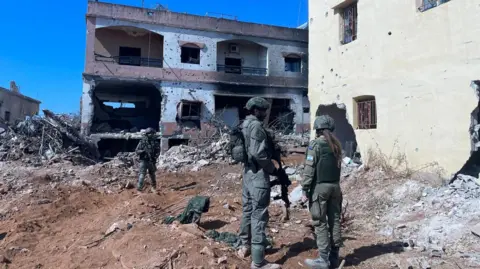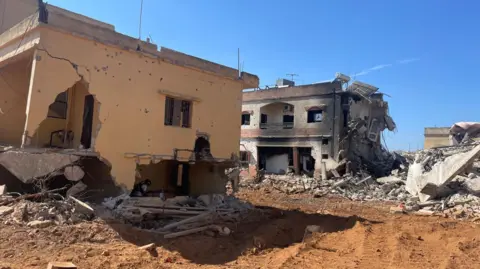 BBC
BBCIsraeli army vehicles had already pounded the dirt road into dust where we crossed into Lebanon, breaking through a hole in the fence that marks the ceasefire line drawn between the two countries a generation ago.
The ceasefire itself is already in tatters.
Israel’s ground invasion along this border last week was launched, it said, to destroy Hezbollah weapons and infrastructure in “limited, localised, targeted raids”.
Ten days on, the army was taking us to a village a couple of miles into Lebanese territory, where it had just established “some level of control”.

We were told not to reveal where it is, for military reasons, and our movements were restricted.
Israeli artillery was blasting through the air as we arrived. The brigade commander, Col Yaniv Malka, told us the area was still not clear of Hezbollah fighters.
Bursts of small-arms fire were from fighting that was taking place 500m away, he said, describing “face-to-face combat” with Hezbollah fighters inside the village just a couple of days before – meaning, he said, “my troops seeing in their eyes, and fighting them in the streets”.
All along the central path through the village, houses lay demolished; piles of rubble leaching glimpses of family life. Buildings left standing were shot through with artillery, missing corners or walls and peppered with gunshot and shrapnel holes.
Two tanks sat in churned up earth near what was once a village square. The level of destruction around them is reminiscent of Gaza.

Our movements on the ground were restricted by the army to a limited area of the village, but neighbouring buildings and communities appeared, from a distance, to be untouched.
These incursions seem – so far – to be more “limited and targeted” geographically than militarily.
The graffiti on a building commandeered by troops read: “We wanted peace, you wanted war”.
“Most of the terrorists ran away,” Col Malka told me. “[But] dozens of houses were booby-trapped. When we went house to house, we discovered booby-traps and weapons. We had no choice but to destroy them.”
We only have the army’s account of what happened here.
We were also shown three caches of weapons it said were found inside civilian homes here, including boxes of brand-new mortars, new anti-tank missiles and mines, as well as sophisticated shoulder launched rockets and night-scopes.
One anti-tank missile we saw was already semi-assembled.
 EPA
EPAThe chief of staff for the 91st Division, Roy Russo, also showed us a garage he said had been used as an equipment warehouse, with sleeping bags, body armour, rifles and ammunition hidden in a large barrel.
“This is what we call an exchange zone,” he said. “They’re morphing from civilians into combatants. All this gear is designed to manoeuvre into [Israel] and conduct operations on the Israeli side. This is not defensive equipment.”
This, Israel says, is why it launched its invasion of southern Lebanon; that Hezbollah’s stockpiles of weapons and equipment along this border were planning for a cross-border attack similar to last year’s 7 October attacks by Hamas in southern Israel.
At the start of this invasion, the army revealed that Israeli special forces had been operating across the Lebanese border in small tactical units for almost a year, conducting more than 70 raids to find and destroy Hezbollah infrastructure, including underground tunnels – one of which, it said, stopped 30m (100ft) before the ceasefire line with Israel and was unfinished.
Col Malka showed me some of the weapons he said the army found on the day we arrived. They include a large IED, an anti-personnel mine, and a high-tech night-scope.
He said troops were finding “two to three times” the number of weapons they found in Gaza, with “thousands” of weapons and thousands of pieces of ammunition found in this village alone.
“We don’t want to hold these places,” he told me. “We want to take all the ammunition and fighting equipment out. After that, we expect the people will come back, and understand that peace is better for them, and terrorist control over them in a bad thing.”
“But I’ll leave that to the diplomats to solve,” he smiled.
After the last ground war between Israel and Hezbollah in 2006, the UN ruled that Hezbollah must pull back north of the Litani River. A previous resolution also ordered its disarmament. Neither decision has been enforced.
 Reuters
ReutersThat ground war in 2006 was a wake-up call for Israel. The Iran-backed militia fought its army to standstill. For almost 20 years, both sides have been avoiding – and preparing for – the next one.
Col Malka fought in Lebanon during that war. “This one is different,” he said.
When I asked why, he replied: “Because of 7th October.”
As we were speaking, the sound of small-arms fire grew louder. He gestured towards it. “That’s my guys fighting in the casbah,” he said.
I asked an army spokesman whether any women or children were present when the operation here began. He replied that all civilians had been given ample warning to leave.
The human rights group Amnesty International this week described Israel’s evacuation warnings in southern Lebanon as inadequate and overly general, and said they did not absolve the country of its obligations under international law.
Israel’s ground invasion is part of a dramatic escalation against Hezbollah over the past three weeks that has also seen it intensify air strikes on southern Lebanon and parts of Beirut.
Lebanon says more than 2,000 people have been killed, mainly during the recent escalation, and hundreds of thousands have been displaced.
Hezbollah began firing rockets into northern Israel on 8 October last year, the day after Hamas’s deadly attack on southern Israel. The Iran-backed group says it is acting in solidarity with the Palestinians and has said it will stop firing if there is a ceasefire between Israel and Hamas in Gaza.
Israel accuses Hezbollah of using civilians as human shields. One commander described the ground war as an offensive operation to defend Israeli citizens – an invasion to stop an invasion, in other words.
But the speed with which Israel’s forces have been moving through villages along this border may only be the first chapter in this story.
Hezbollah tactics have shifted since the ground invasion began, with Israeli towns like Metula – surrounded on three sides by Lebanon – reporting a drop in direct fire from anti-tank missiles, and a rise in rockets fired out of sight from further away.
The assessment of many is that Hezbollah fighters have not run away, but simply withdrawn further back into Lebanon.
Israel already has four divisions lined up at this border – and a growing chorus of voices inside the country who say this is the moment, not just to push back Hezbollah, but to remake the Middle East.
As the fighting near the village intensified, we were told to leave immediately, hurried out to the waiting convoy.
Under the shadow of a growing conflict with Iran, Israel’s small successes along this frontier don’t change one key fact: this is not actually a border war, it’s a regional war being fought along a border.

